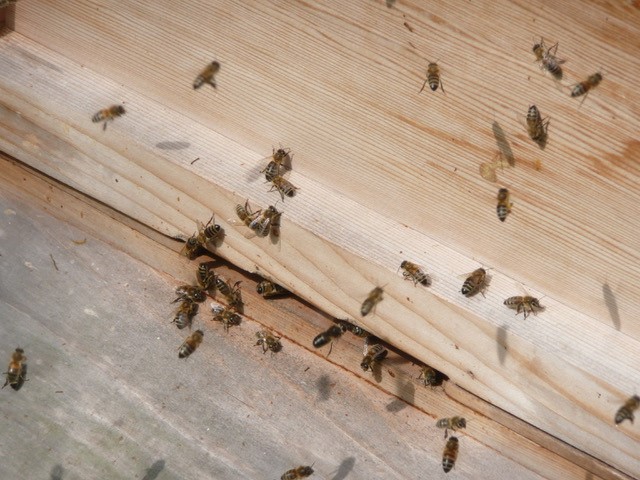Bee Blog May
01 May 2019
I am Gerald Bushby (pronounced bush bee!) a beekeeper in Weston on the Green, a small village in Oxfordshire. I am going to be writing a monthly blog about the bees in my apiary. I hope you will find it interesting. I should start by saying that I am not an expert, having only kept bees for three years. Anything I say is my own personal opinion; I accept that there may often be other views and opinions.
The bee season has started to move into full swing. The bees have been very active in April encouraged by more fine weather. Towards the end of the month and over the Easter holiday period we have had some excellent weather with clear blue skies day after day and very warm temperatures similar to typical July days.
Given that my three hives are adjacent to each other and share the same micro climate it would perhaps be reasonable to expect, as I did, that all three colonies would react in the same way to the fine weather. I had expected the larger colony, that has been in existence for several years and which last month was the largest of the three, would be the most active. Not so. It has been the two smaller colonies, which last month had only expanded to three frames, where I have seen most activity and expansion this month.
During the middle of the month I noticed that the two new colonies, with the red queens, were both extremely active with hundreds of bees flowing in and out for most of the daylight hours. I carried out an inspection of the brood boxes and found an almost text book expansion, brood at all stages, pollen and nectar being stored and an expansion to fill five of the ten frames.
With such rapid growth my first concern was to ensure that the colonies had sufficient space for their expansion. Too little space is thought to be a large factor in bees deciding to swarm, so better safe than sorry I added a “super” to all three hives. This is an extra box on top of the brood box in which the bees can store honey but separated from the brood box by a wire framework through which the queen cannot pass so as to stop her from moving into the super and laying eggs. As the queen is unable to lay eggs in the super the bees only store honey there. There may be the odd cell of pollen but generally the bees store the pollen close to where the eggs are.
After a week I carried out another inspection and found that the super on both the red queen hives, which each consists of ten frames, was half full of honey. Time to add another super to these two hives. After another week I took another look. On both the red queen hives the bottom super was two thirds full and the top super was half full.
What of the super on the original hive, the white queen? To my surprise the bees there have not stored any honey at all in the super put on for their expansion. Why the difference? The answer is I do not know. There appears to be nothing wrong with the white queens hive. I have seen her and she is laying eggs and there was brood at all stages and the bees look fine. There has been expansion from five frames to seven in the brood box. They are storing honey in the brood box but for some reason there does not seem to have been the rapid expansion and very large increase in number as there has been in the red queens hives.
It may be that as there still several frames of honey stores left over from last winter on which the bees can feed that they do not find the need to be rushed into finding new supplies of nectar when they already have an adequate supply of food. The two red queen colonies were new last autumn and did not have the time to build up such extensive stores as the white queen so perhaps they have taken the opportunity of the good weather to expand rapidly and collect the available nectar to provide as much stores as possible. Are the bees like us? If the cupboard is full why rush out to the supermarket?
Another possibility is that the bees in the two red queen hives have found a nearby field of oil seed rape and the white queens bees have not. Bees love the flowers of oil seed rape. If they fine it they gorge themselves.
Whatever the reason for this different behavior, as a precaution I will have to wait until the oil seed rape has finished flowering and then remove all of the available ripe honey from all of the hives so as it does not mix with nectar from summer flowers. Oil seed rape honey sets solid and I will have to wait several weeks for this to happen before I cream the honey so that it can be spread easily.
The season has got off to a good start, long may it continue.
I am a proud supporter of the ‘Bees for development’ charity, my love of the bee drew me to this wonderful UK based charity and the great work they do around the world with Bees and the impact they can have on people’s lives. Please help me support this wonderful organisation, as 2BScientific will be doing with donations to this hard-working charity.
